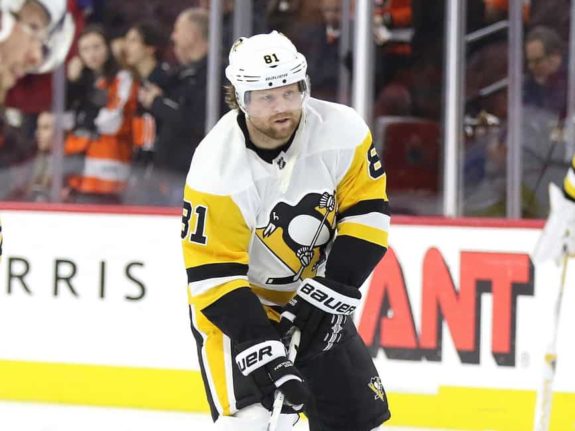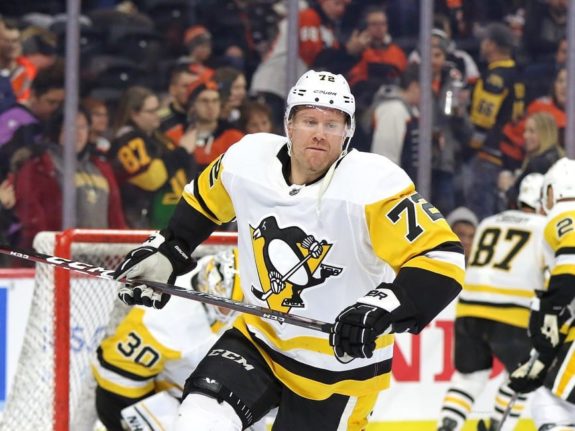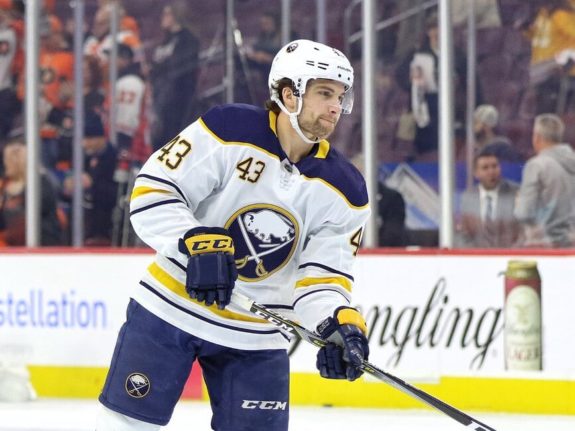
 Tyler Bowen
The Hockey Writers
Tyler Bowen
The Hockey Writers
39
Reads
0
Comments
Penguins’ Best and Worst Trades of the Decade
The Pittsburgh Penguins have spent the last decade with higher expectations than almost any other NHL squad. Stacked with high-end talent and depth to make deep playoff runs, the team has constantly been in win-now mode throughout Sidney Crosby and Evgeni Malkin’s primes.
Part of the reason the Penguins have been competitive for so long is the aggressiveness displayed by Ray Shero and Jim Rutherford as the team’s general managers (GM) over the last decade. Neither GM has ever been shy about making a big splash on the trade market, even if it doesn’t always work out. What are some of the Penguins’ best and worst trades over the last decade?
Best Trades of the Decade
The combination of team success and front office aggression has certainly yielded some great results. There are at least a dozen impactful trades over the last decade that you could make a case for thanks to a pair of Stanley Cup wins and a handful of other deep playoff runs. However, there are a few that stand out from the pack.
Penguins Acquire Phil Kessel in Blockbuster
This one was easily the biggest no-brainer of all. In one of the biggest trades in franchise history, the Penguins sent a handful of players (including their recent first-round pick Kasperi Kapanen) and two picks (first and third rounds) to the Toronto Maple Leafs for Phil Kessel. Pittsburgh also received a second-round selection in return. On top of that, the Maple Leafs actually retained a bit of his salary to help make this deal work.
This July 2015 trade truly signified that the Penguins were all-in for a Stanley Cup chase and it worked wonders. Kessel racked up 110 goals and 303 points over four seasons with Pittsburgh, including his first career 90-point campaign in 2017-18. More importantly, he scored 45 points in 49 postseason games during the back-to-back Stanley Cup runs.

This trade and the firing of head coach Mike Johnston just months later set the course for the future of the franchise. As a bonus, later that month, the Penguins acquired Nick Bonino from the Vancouver Canucks in a deal that narrowly missed the cut on this list. Pittsburgh sent Brandon Sutter in exchange and actually flipped its third-round pick for a second-rounder in that deal. That pick would be used on Filip Gustavsson.
While Kessel’s time in Pittsburgh came to an end in a less-than-positive way during the 2019 offseason, he’ll be immortalized in Pittsburgh sports history forever; the Penguins would not have won those back-to-back Cups without him.
Penguins Swap Neal for Hornqvist
While the Kessel acquisition was the best and biggest deal, the trade for Patric Hornqvist may have been the most impactful as it was Rutherford’s first important move as Pittsburgh’s GM. In June 2014, just a couple of weeks after Rutherford’s hiring, the Penguins sent James Neal to the Nashville Predators for Hornqvist and Nick Spaling.

While Neal was still a solid winger and regular point-per-game scorer at the time, Hornqvist helped change the team’s identity. He immediately found chemistry with Crosby and gave opposing goalies nightmares down low. He’s physical and a pest to play against, but was still a consistent offensive threat with at least 20 goals in each of his first four seasons with the Penguins.
Scuderi Shipped Out for Daley
When talking about the Penguins back-to-back championships, there are always a few overlooked players. Arguably the most underrated player during that time was defenseman Trevor Daley. Just two days after the firing of Johnston in December 2015, Rutherford shipped Rob Scuderi to the Chicago Blackhawks for Daley in a one-for-one deal.
Daley was better than Scuderi in nearly every regard and the trade immediately looked like highway robbery for the Penguins. The 5-foot-11 blueliner scored 41 points in 109 games with Pittsburgh during its two Stanley Cup-winning seasons. He also notched another 11 points in 36 postseason appearances with the team.
More importantly, he and the rest of the defensive group, stepped up big time during the 2017 playoffs after Kris Letang’s neck surgery held him out for the entire run. It was a terrific effort by the entire unit, but Daley’s veteran leadership was certainly noticed.
Penguins Land Iginla for Playoff Run
While he may have already been out of his prime, it was still a big deal when the Penguins reeled in a future Hall of Fame forward in Jarome Iginla prior to the 2013 trade deadline. He scored 11 points in 13 regular season games before collecting another 12 points in 15 postseason contests.
Overall, the trade itself worked out great as the Penguins made it to the Eastern Conference Final. Unfortunately, they ran into the Boston Bruins and Tuukka Rask who was an absolute buzzsaw in that series; the Penguins were swept and Iginla would actually sign a one-year deal with the Bruins the following offseason.
Perhaps the best news of the trade is that none of the assets given up were too significant. Kenny Agostino and Ben Hanowski combined to scored five points in their respective Calgary Flames careers. The first-round pick that Pittsburgh parted with was used on Morgan Klimchuk who has just one NHL game in his career.
Worst Trades of the Decade
Of course, even with back-to-back Stanley Cup wins and the NHL’s longest active postseason streak, no one’s perfect. Because the team has been so competitive, most bad trades don’t look quite as malignant as other teams’ would. Still, there have been a few big mistakes by Rutherford and Shero over the last decade.
Penguins Acquire Ryan Reaves from Blues
In an attempt to get bigger and more physical in the 2017 offseason, Rutherford brought in Ryan Reaves, a big-bodied bruiser. He was coming off career highs in goals (7) and points (13) with the St. Louis Blues during the 2016-17 season. The Penguins received Reaves and a second-round pick in exchange for Oskar Sundqvist and a first-round pick.

It was a drastic over-payment to begin with, but Reaves did exactly what he was expected to: he threw his weight around, got in a handful of fights, and averaged under seven minutes of ice time per game. His tenure with the Penguins lasted only 58 games before he was flipped to the Vegas Golden Knights in a three-team deal where the Penguins landed Derick Brassard from the Ottawa Senators. It was hardly worth a young forward and first-round pick.
Meanwhile, Sundqvist reached a new level with the Stanley Cup-winning Blues last season, scoring 14 goals and 31 points before tallying another nine points in the postseason. Klim Kostin, the prospect taken with the Penguins draft pick, is currently one of the Blues top prospects and made his NHL debut this season.
Penguins Send Sheary, Hunwick to Sabres
Normally, this would have actually been a pretty solid move. After signing Matt Hunwick to a three-year, $6.75 million deal in the 2017 offseason, the Penguins used Conor Sheary as a sweetener to clear up over $5 million in cap space in June 2018. In return, the Buffalo Sabres sent a 2019 fourth-round pick that was used to trade up for Nathan Legare.

Unfortunately, less than a week later, most of that freed up cap space was used on a five-year, $16.25 million deal for Jack Johnson. As bad as Hunwick was for most of his Penguins tenure, he was cheaper and his contract would’ve been off the books after the 2019-20 season.
Sheary wasn’t as effective in his final season as a Penguin but he could still suffice as a solid middle-six winger. Had that cap space been used more efficiently — whether in free agency or another trade — this would’ve been a run-of-the-mill cap dump. Instead, the Penguins are still tethered to a bad contract for the near future.
Penguins Swing Big for Murray
Just days before the Iginla trade, the Penguins also added a blueliner for their soon-to-be playoff run. The team sent two picks (second and third round) to the San Jose Sharks in exchange for Douglas Murray. The Swedish defenseman was never much of an offensive threat but the Penguins were more interested in his physical side.
As mentioned with Iginla, the Penguins did have a pretty successful postseason run in 2013, but the overpayment for an ineffective Murray didn’t move the needle very much. He scored just 6 points in 29 games between the regular season and playoffs. The following offseason, the 6-foot-3 blueliner signed with the Montreal Canadiens.
The Penguins second-round pick would later be traded to the Detroit Red Wings and used to select Tyler Bertuzzi. The 24-year-old winger is proving to be a solid young player; after scoring 47 points last season, Bertuzzi has racked up 10 goals and 24 points so far during the 2019-20 season.
The Penguins have made far more good trades than bad ones over the last decade, and in franchise history for the most part. Nearly every trade that Rutherford made from 2014-2016 worked out incredibly well in the form of two championships. However, fans will always be left wondering whether Klim Kostin could’ve been the next great, young forward for the team or whether Sheary would’ve earned his way back into the top-six.
The post Penguins’ Best and Worst Trades of the Decade appeared first on The Hockey Writers.
Popular Articles

















































 Blackhawks Chicago
Blackhawks Chicago Panthers Florida
Panthers Florida Penguins Pittsburgh
Penguins Pittsburgh Rangers New York
Rangers New York Avalanche Colorado
Avalanche Colorado Kings Los Angeles
Kings Los Angeles Maple Leafs Toronto
Maple Leafs Toronto Bruins Boston
Bruins Boston Capitals Washington
Capitals Washington Flames Calgary
Flames Calgary Oilers Edmonton
Oilers Edmonton Golden Knights Vegas
Golden Knights Vegas Senators Ottawa
Senators Ottawa Lightning Tampa Bay
Lightning Tampa Bay Flyers Philadelphia
Flyers Philadelphia Islanders New York
Islanders New York Sabres Buffalo
Sabres Buffalo Red Wings Detroit
Red Wings Detroit Devils New Jersey
Devils New Jersey Hurricanes Carolina
Hurricanes Carolina Blue Jackets Columbus
Blue Jackets Columbus Predators Nashville
Predators Nashville Wild Minnesota
Wild Minnesota Blues St. Louis
Blues St. Louis Stars Dallas
Stars Dallas Jets Winnipeg
Jets Winnipeg Mammoth Utah
Mammoth Utah Sharks San Jose
Sharks San Jose Canucks Vancouver
Canucks Vancouver Ducks Anaheim
Ducks Anaheim






